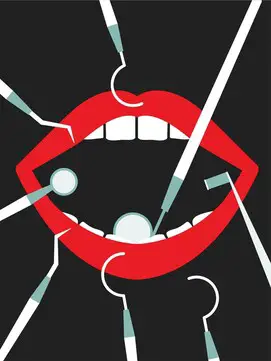|
This article was originally published by The Atlantic. Story by Ferris Jabr  It's much less scientific—and more prone to gratuitous procedures—than you may think. It’s much less scientific—and more prone to gratuitous procedures—than you may think.In the early 2000s Terry Mitchell’s dentist retired. For a while, Mitchell, an electrician in his 50s, stopped seeking dental care altogether. But when one of his wisdom teeth began to ache, he started looking for someone new. An acquaintance recommended John Roger Lund, whose practice was a convenient 10-minute walk from Mitchell’s home, in San Jose, California. Lund’s practice was situated in a one-story building with clay roof tiles that housed several dental offices. The interior was a little dated, but not dingy. The waiting room was small and the decor minimal: some plants and photos, no fish. Lund was a good-looking middle-aged guy with arched eyebrows, round glasses, and graying hair that framed a youthful face. He was charming, chatty, and upbeat. At the time, Mitchell and Lund both owned Chevrolet Chevelles, and they bonded over their mutual love of classic cars. Lund extracted the wisdom tooth with no complications, and Mitchell began seeing him regularly. He never had any pain or new complaints, but Lund encouraged many additional treatments nonetheless. A typical person might get one or two root canals in a lifetime. In the space of seven years, Lund gave Mitchell nine root canals and just as many crowns. Mitchell’s insurance covered only a small portion of each procedure, so he paid a total of about $50,000 out of pocket. The number and cost of the treatments did not trouble him. He had no idea that it was unusual to undergo so many root canals—he thought they were just as common as fillings. The payments were spread out over a relatively long period of time. And he trusted Lund completely. He figured that if he needed the treatments, then he might as well get them before things grew worse. Meanwhile, another of Lund’s patients was going through a similar experience. Joyce Cordi, a businesswoman in her 50s, had learned of Lund through 1-800-DENTIST. She remembers the service giving him an excellent rating. When she visited Lund for the first time, in 1999, she had never had so much as a cavity. To the best of her knowledge her teeth were perfectly healthy, although she’d had a small dental bridge installed to fix a rare congenital anomaly (she was born with one tooth trapped inside another and had had them extracted). Within a year, Lund was questioning the resilience of her bridge and telling her she needed root canals and crowns. Cordi was somewhat perplexed. Why the sudden need for so many procedures after decades of good dental health? When she expressed uncertainty, she says, Lund always had an answer ready. The cavity on this tooth was in the wrong position to treat with a typical filling, he told her on one occasion. Her gums were receding, which had resulted in tooth decay, he explained during another visit. Clearly she had been grinding her teeth. And, after all, she was getting older. As a doctor’s daughter, Cordi had been raised with an especially respectful view of medical professionals. Lund was insistent, so she agreed to the procedures. Over the course of a decade, Lund gave Cordi 10 root canals and 10 crowns. He also chiseled out her bridge, replacing it with two new ones that left a conspicuous gap in her front teeth. Altogether, the work cost her about $70,000. A masked figure looms over your recumbent body, wielding power tools and sharp metal instruments, doing things to your mouth you cannot see. In early 2012, Lund retired. Brendon Zeidler, a young dentist looking to expand his business, bought Lund’s practice and assumed responsibility for his patients. Within a few months, Zeidler began to suspect that something was amiss. Financial records indicated that Lund had been spectacularly successful, but Zeidler was making only 10 to 25 percent of Lund’s reported earnings each month. As Zeidler met more of Lund’s former patients, he noticed a disquieting trend: Many of them had undergone extensive dental work—a much larger proportion than he would have expected. When Zeidler told them, after routine exams or cleanings, that they didn’t need any additional procedures at that time, they tended to react with surprise and concern: Was he sure? Nothing at all? Had he checked thoroughly? In the summer, Zeidler decided to take a closer look at Lund’s career. He gathered years’ worth of dental records and bills for Lund’s patients and began to scrutinize them, one by one. The process took him months to complete. What he uncovered was appalling. We have a fraught relationship with dentists as authority figures. In casual conversation we often dismiss them as “not real doctors,” regarding them more as mechanics for the mouth. But that disdain is tempered by fear. For more than a century, dentistry has been half-jokingly compared to torture. Surveys suggest that up to 61 percent of people are apprehensive about seeing the dentist, perhaps 15 percent are so anxious that they avoid the dentist almost entirely, and a smaller percentage have a genuine phobia requiring psychiatric intervention. When you’re in the dentist’s chair, the power imbalance between practitioner and patient becomes palpable. A masked figure looms over your recumbent body, wielding power tools and sharp metal instruments, doing things to your mouth you cannot see, asking you questions you cannot properly answer, and judging you all the while. The experience simultaneously invokes physical danger, emotional vulnerability, and mental limpness. A cavity or receding gum line can suddenly feel like a personal failure. When a dentist declares that there is a problem, that something must be done before it’s too late, who has the courage or expertise to disagree? When he points at spectral smudges on an X-ray, how are we to know what’s true? In other medical contexts, such as a visit to a general practitioner or a cardiologist, we are fairly accustomed to seeking a second opinion before agreeing to surgery or an expensive regimen of pills with harsh side effects. But in the dentist’s office—perhaps because we both dread dental procedures and belittle their medical significance—the impulse is to comply without much consideration, to get the whole thing over with as quickly as possible. The uneasy relationship between dentist and patient is further complicated by an unfortunate reality: Common dental procedures are not always as safe, effective, or durable as we are meant to believe. As a profession, dentistry has not yet applied the same level of self-scrutiny as medicine, or embraced as sweeping an emphasis on scientific evidence. “We are isolated from the larger health-care system. So when evidence-based policies are being made, dentistry is often left out of the equation,” says Jane Gillette, a dentist in Bozeman, Montana, who works closely with the American Dental Association’s Center for Evidence-Based Dentistry, which was established in 2007. “We’re kind of behind the times, but increasingly we are trying to move the needle forward.” Consider the maxim that everyone should visit the dentist twice a year for cleanings. We hear it so often, and from such a young age, that we’ve internalized it as truth. But this supposed commandment of oral health has no scientific grounding. Scholars have traced its origins to a few potential sources, including a toothpaste advertisement from the 1930s and an illustrated pamphlet from 1849 that follows the travails of a man with a severe toothache. Today, an increasing number of dentists acknowledge that adults with good oral hygiene need to see a dentist only once every 12 to 16 months. Many standard dental treatments—to say nothing of all the recent innovations and cosmetic extravagances—are likewise not well substantiated by research. Many have never been tested in meticulous clinical trials. And the data that are available are not always reassuring. The Cochrane organization, a highly respected arbiter of evidence-based medicine, has conducted systematic reviews of oral-health studies since 1999. In these reviews, researchers analyze the scientific literature on a particular dental intervention, focusing on the most rigorous and well-designed studies. In some cases, the findings clearly justify a given procedure. For example, dental sealants—liquid plastics painted onto the pits and grooves of teeth like nail polish—reduce tooth decay in children and have no known risks. (Despite this, they are not widely used, possibly because they are too simple and inexpensive to earn dentists much money.) But most of the Cochrane reviews reach one of two disheartening conclusions: Either the available evidence fails to confirm the purported benefits of a given dental intervention, or there is simply not enough research to say anything substantive one way or another. Fluoridation of drinking water seems to help reduce tooth decay in children, but there is insufficient evidence that it does the same for adults. Some data suggest that regular flossing, in addition to brushing, mitigates gum disease, but there is only “weak, very unreliable” evidence that it combats plaque. As for common but invasive dental procedures, an increasing number of dentists question the tradition of prophylactic wisdom-teeth removal; often, the safer choice is to monitor unproblematic teeth for any worrying developments. Little medical evidence justifies the substitution of tooth-colored resins for typical metal amalgams to fill cavities. And what limited data we have don’t clearly indicate whether it’s better to repair a root-canaled tooth with a crown or a filling. When Cochrane researchers tried to determine whether faulty metal fillings should be repaired or replaced, they could not find a single study that met their standards. “The body of evidence for dentistry is disappointing,” says Derek Richards, the director of the Centre for Evidence-Based Dentistry at the University of Dundee, in Scotland. “Dentists tend to want to treat or intervene. They are more akin to surgeons than they are to physicians. We suffer a little from that. Everybody keeps fiddling with stuff, trying out the newest thing, but they don’t test them properly in a good-quality trial.” The general dearth of rigorous research on dental interventions gives dentists even more leverage over their patients. Should a patient somehow muster the gumption to question an initial diagnosis and consult the scientific literature, she would probably not find much to help her. When we submit to a dentist’s examination, we are putting a great deal of trust in that dentist’s experience and intuition—and, of course, integrity. When zeidler purchased lund’s practice, in February 2012, he inherited a massive collection of patients’ dental histories and bills, a mix of electronic documents, handwritten charts, and X‑rays. By August, Zeidler had decided that if anything could explain the alarmingly abundant dental work in the mouths of Lund’s patients, he would find it in those records. He spent every weekend for the next nine months examining the charts of hundreds of patients treated in the preceding five years. In a giant Excel spreadsheet, he logged every single procedure Lund had performed, so he could carry out some basic statistical analyses. The numbers spoke for themselves. Year after year, Lund had performed certain procedures at extraordinarily high rates. Whereas a typical dentist might perform root canals on previously crowned teeth in only 3 to 7 percent of cases, Lund was performing them in 90 percent of cases. As Zeidler later alleged in court documents, Lund had performed invasive, costly, and seemingly unnecessary procedures on dozens and dozens of patients, some of whom he had been seeing for decades. Terry Mitchell and Joyce Cordi were far from alone. In fact, they had not even endured the worst of it. Whereas medicine has reckoned with some of its own tendencies toward excessive and misguided treatment, dentistry has lagged behind. Dental crowns were one of Lund’s most frequent treatments. A crown is a metal or ceramic cap that completely encases an injured or decayed tooth, which is first shaved to a peg so its new shell will fit. Crowns typically last 10 to 15 years. Lund not only gave his patients superfluous crowns; he also tended to replace them every five years—the minimum interval of time before insurance companies will cover the procedure again. More than 50 of Lund’s patients also had ludicrously high numbers of root canals: 15, 20, 24. (A typical adult mouth has 32 teeth.) According to one lawsuit that has since been settled, a woman in her late 50s came to Lund with only 10 natural teeth; from 2003 to 2010, he gave her nine root canals and 12 crowns. The American Association of Endodontists claims that a root canal is a “quick, comfortable procedure” that is “very similar to a routine filling.” In truth, a root canal is a much more radical operation than a filling. It takes longer, can cause significant discomfort, and may require multiple trips to a dentist or specialist. It’s also much more costly. Read: Americans are going to Juarez for cheap dental care Root canals are typically used to treat infections of the pulp—the soft living core of a tooth. A dentist drills a hole through a tooth in order to access the root canals: long, narrow channels containing nerves, blood vessels, and connective tissue. The dentist then repeatedly twists skinny metal files in and out of the canals to scrape away all the living tissue, irrigates the canals with disinfectant, and packs them with a rubberlike material. The whole process usually takes one to two hours. Afterward, sometimes at a second visit, the dentist will strengthen the tooth with a filling or crown. In the rare case that infection returns, the patient must go through the whole ordeal again or consider more advanced surgery. Zeidler noticed that nearly every time Lund gave someone a root canal, he also charged for an incision and drainage, known as an I&D. During an I&D, a dentist lances an abscess in the mouth and drains the exudate, all while the patient is awake. In some cases the dentist slips a small rubber tube into the wound, which continues to drain fluids and remains in place for a few days. I&Ds are not routine adjuncts to root canals. They should be used only to treat severe infections, which occur in a minority of cases. Yet they were extremely common in Lund’s practice. In 2009, for example, Lund billed his patients for 109 I&Ds. Zeidler asked many of those patients about the treatments, but none of them recalled what would almost certainly have been a memorable experience. In addition to performing scores of seemingly unnecessary procedures that could result in chronic pain, medical complications, and further operations, Lund had apparently billed patients for treatments he had never administered. Zeidler was alarmed and distressed. “We go into this profession to care for patients,” he told me. “That is why we become doctors. To find, I felt, someone was doing the exact opposite of that—it was very hard, very hard to accept that someone was willing to do that.” Zeidler knew what he had to do next. As a dental professional, he had certain ethical obligations. He needed to confront Lund directly and give him the chance to account for all the anomalies. Even more daunting, in the absence of a credible explanation, he would have to divulge his discoveries to the patients Lund had bequeathed to him. He would have to tell them that the man to whom they had entrusted their care—some of them for two decades—had apparently deceived them for his own profit. The idea of the dentist as potential charlatan has a long and rich history. In medieval Europe, barbers didn’t just trim hair and shave beards; they were also surgeons, performing a range of minor operations including bloodletting, the administration of enemas, and tooth extraction. Barber surgeons, and the more specialized “tooth drawers,” would wrench, smash, and knock teeth out of people’s mouths with an intimidating metal instrument called a dental key: Imagine a chimera of a hook, a hammer, and forceps. Sometimes the results were disastrous. In the 1700s, Thomas Berdmore, King George III’s “Operator for the Teeth,” described one woman who lost “a piece of jawbone as big as a walnut and three neighbouring molars” at the hands of a local barber. Barber surgeons came to America as early as 1636. By the 18th century, dentistry was firmly established in the colonies as a trade akin to blacksmithing (Paul Revere was an early American craftsman of artisanal dentures). Itinerant dentists moved from town to town by carriage with carts of dreaded tools in tow, temporarily setting up shop in a tavern or town square. They yanked teeth or bored into them with hand drills, filling cavities with mercury, tin, gold, or molten lead. For anesthetic, they used arsenic, nutgalls, mustard seed, leeches. Mixed in with the honest tradesmen—who genuinely believed in the therapeutic power of bloodsucking worms—were swindlers who urged their customers to have numerous teeth removed in a single sitting or charged them extra to stuff their pitted molars with homemade gunk of dubious benefit. In the mid-19th century, a pair of American dentists began to elevate their trade to the level of a profession. From 1839 to 1840, Horace Hayden and Chapin Harris established dentistry’s first college, scientific journal, and national association. Some historical accounts claim that Hayden and Harris approached the University of Maryland’s School of Medicine about adding dental instruction to the curriculum, only to be rebuffed by the resident physicians, who declared that dentistry was of little consequence. But no definitive proof of this encounter has ever surfaced. Whatever happened, from that point on, “the professions of dentistry and medicine would develop along separate paths,” writes Mary Otto, a health journalist, in her recent book, Teeth. Becoming a practicing physician requires four years of medical school followed by a three-to-seven-year residency program, depending on the specialty. Dentists earn a degree in four years and, in most states, can immediately take the national board exams, get a license, and begin treating patients. (Some choose to continue training in a specialty, such as orthodontics or oral and maxillofacial surgery.) When physicians complete their residency, they typically work for a hospital, university, or large health-care organization with substantial oversight, strict ethical codes, and standardized treatment regimens. By contrast, about 80 percent of the nation’s 200,000 active dentists have individual practices, and although they are bound by a code of ethics, they typically don’t have the same level of oversight. Read: Why dentistry is separate from medicine Throughout history, many physicians have lamented the segregation of dentistry and medicine. Acting as though oral health is somehow divorced from one’s overall well-being is absurd; the two are inextricably linked. Oral bacteria and the toxins they produce can migrate through the bloodstream and airways, potentially damaging the heart and lungs. Poor oral health is associated with narrowing arteries, cardiovascular disease, stroke, and respiratory disease, possibly due to a complex interplay of oral microbes and the immune system. And some research suggests that gum disease can be an early sign of diabetes, indicating a relationship between sugar, oral bacteria, and chronic inflammation. Dentistry’s academic and professional isolation has been especially detrimental to its own scientific inquiry. Most major medical associations around the world have long endorsed evidence-based medicine. The idea is to shift focus away from intuition, anecdote, and received wisdom, and toward the conclusions of rigorous clinical research. Although the phrase evidence-based medicine was coined in 1991, the concept began taking shape in the 1960s, if not earlier (some scholars trace its origins all the way back to the 17th century). In contrast, the dental community did not begin having similar conversations until the mid-1990s. There are dozens of journals and organizations devoted to evidence-based medicine, but only a handful devoted to evidence-based dentistry. In the past decade, a small cohort of dentists has worked diligently to promote evidence-based dentistry, hosting workshops, publishing clinical-practice guidelines based on systematic reviews of research, and creating websites that curate useful resources. But its adoption “has been a relatively slow process,” as a 2016 commentary in the Contemporary Clinical Dentistry journal put it. Part of the problem is funding: Because dentistry is often sidelined from medicine at large, it simply does not receive as much money from the government and industry to tackle these issues. “At a recent conference, very few practitioners were even aware of the existence of evidence-based clinical guidelines,” says Elliot Abt, a professor of oral medicine at the University of Illinois. “You can publish a guideline in a journal, but passive dissemination of information is clearly not adequate for real change.” Among other problems, dentistry’s struggle to embrace scientific inquiry has left dentists with considerable latitude to advise unnecessary procedures—whether intentionally or not. The standard euphemism for this proclivity is overtreatment. Favored procedures, many of which are elaborate and steeply priced, include root canals, the application of crowns and veneers, teeth whitening and filing, deep cleaning, gum grafts, fillings for “microcavities”—incipient lesions that do not require immediate treatment—and superfluous restorations and replacements, such as swapping old metal fillings for modern resin ones. Whereas medicine has made progress in reckoning with at least some of its own tendencies toward excessive and misguided treatment, dentistry is lagging behind. It remains “largely focused upon surgical procedures to treat the symptoms of disease,” Mary Otto writes. “America’s dental care system continues to reward those surgical procedures far more than it does prevention.” “Excessive diagnosis and treatment are endemic,” says Jeffrey H. Camm, a dentist of more than 35 years who wryly described his peers’ penchant for “creative diagnosis” in a 2013 commentary published by the American Dental Association. “I don’t want to be damning. I think the majority of dentists are pretty good.” But many have “this attitude of ‘Oh, here’s a spot, I’ve got to do something.’ I’ve been contacted by all kinds of practitioners who are upset because patients come in and they already have three crowns, or 12 fillings, or another dentist told them that their 2-year-old child has several cavities and needs to be sedated for the procedure.” Trish Walraven, who worked as a dental hygienist for 25 years and now manages a dental-software company with her husband in Texas, recalls many troubling cases: “We would see patients seeking a second opinion, and they had treatment plans telling them they need eight fillings in virgin teeth. We would look at X-rays and say, ‘You’ve got to be kidding me.’ It was blatantly overtreatment—drilling into teeth that did not need it whatsoever.” Joyce Cordi’s new dentist says her X-rays resemble those of someone who had reconstructive facial surgery following a car crash. Studies that explicitly focus on overtreatment in dentistry are rare, but a recent field experiment provides some clues about its pervasiveness. A team of researchers at ETH Zurich, a Swiss university, asked a volunteer patient with three tiny, shallow cavities to visit 180 randomly selected dentists in Zurich. The Swiss Dental Guidelines state that such minor cavities do not require fillings; rather, the dentist should monitor the decay and encourage the patient to brush regularly, which can reverse the damage. Despite this, 50 of the 180 dentists suggested unnecessary treatment. Their recommendations were incongruous: Collectively, the overzealous dentists singled out 13 different teeth for drilling; each advised one to six fillings. Similarly, in an investigation for Reader’s Digest, the writer William Ecenbarger visited 50 dentists in 28 states in the U.S. and received prescriptions ranging from a single crown to a full-mouth reconstruction, with the price tag starting at about $500 and going up to nearly $30,000. A multitude of factors has conspired to create both the opportunity and the motive for widespread overtreatment in dentistry. In addition to dentistry’s seclusion from the greater medical community, its traditional emphasis on procedure rather than prevention, and its lack of rigorous self-evaluation, there are economic explanations. The financial burden of entering the profession is high and rising. In the U.S., the average debt of a dental-school graduate is more than $200,000. And then there’s the expense of finding an office, buying new equipment, and hiring staff to set up a private practice. A dentist’s income is entirely dependent on the number and type of procedures he or she performs; a routine cleaning and examination earns only a baseline fee of about $200. In parallel with the rising cost of dental school, the amount of tooth decay in many countries’ populations has declined dramatically over the past four decades, mostly thanks to the introduction of mass-produced fluoridated toothpaste in the 1950s and ’60s. In the 1980s, with fewer genuine problems to treat, some practitioners turned to the newly flourishing industry of cosmetic dentistry, promoting elective procedures such as bleaching, teeth filing and straightening, gum lifts, and veneers. It’s easy to see how dentists, hoping to buoy their income, would be tempted to recommend frequent exams and proactive treatments—a small filling here, a new crown there—even when waiting and watching would be better. It’s equally easy to imagine how that behavior might escalate. “If I were to sum it up, I really think the majority of dentists are great. But for some reason we seem to drift toward this attitude of ‘I’ve got tools so I’ve got to fix something’ much too often,” says Jeffrey Camm. “Maybe it’s greed, or paying off debt, or maybe it’s someone’s training. It’s easy to lose sight of the fact that even something that seems minor, like a filling, involves removal of a human body part. It just adds to the whole idea that you go to a physician feeling bad and you walk out feeling better, but you go to a dentist feeling good and you walk out feeling bad.”  In the summer of 2013, Zeidler asked several other dentists to review Lund’s records. They all agreed with his conclusions. The likelihood that Lund’s patients genuinely needed that many treatments was extremely low. And there was no medical evidence to justify many of Lund’s decisions or to explain the phantom procedures. Zeidler confronted Lund about his discoveries in several face-to-face meetings. When I asked Zeidler how those meetings went, he offered a single sentence—“I decided shortly thereafter to take legal action”—and declined to comment further. (Repeated attempts were made to contact Lund and his lawyer for this story, but neither responded.) One by one, Zeidler began to write, call, or sit down with patients who had previously been in Lund’s care, explaining what he had uncovered. They were shocked and angry. Lund had been charismatic and professional. They had assumed that his diagnoses and treatments were meant to keep them healthy. Isn’t that what doctors do? “It makes you feel like you have been violated,” Terry Mitchell says—“somebody performing stuff on your body that doesn’t need to be done.” Joyce Cordi recalls a “moment of absolute fury” when she first learned of Lund’s deceit. On top of all the needless operations, “there were all kinds of drains and things that I paid for and the insurance company paid for that never happened,” she says. “But you can’t read the dentalese.” “A lot of them felt, How can I be so stupid? Or Why didn’t I go elsewhere?” Zeidler says. “But this is not about intellect. It’s about betrayal of trust.” In October 2013, Zeidler sued Lund for misrepresenting his practice and breaching their contract. In the lawsuit, Zeidler and his lawyers argued that Lund’s reported practice income of $729,000 to $988,000 a year was “a result of fraudulent billing activity, billing for treatment that was unnecessary and billing for treatment which was never performed.” The suit was settled for a confidential amount. From 2014 to 2017, 10 of Lund’s former patients, including Mitchell and Cordi, sued him for a mix of fraud, deceit, battery, financial elder abuse, and dental malpractice. They collectively reached a nearly $3 million settlement, paid out by Lund’s insurance company. (Lund did not admit to any wrongdoing.) Lund was arrested in May 2016 and released on $250,000 bail. The Santa Clara County district attorney’s office is prosecuting a criminal case against him based on 26 counts of insurance fraud. At the time of his arraignment, he said he was innocent of all charges. The Dental Board of California is seeking to revoke or suspend Lund’s license, which is currently inactive. Many of Lund’s former patients worry about their future health. A root canal is not a permanent fix. It requires maintenance and, in the long run, may need to be replaced with a dental implant. One of Mitchell’s root canals has already failed: The tooth fractured, and an infection developed. He said that in order to treat the infection, the tooth was extracted and he underwent a multistage procedure involving a bone graft and months of healing before an implant and a crown were fixed in place. “I don’t know how much these root canals are going to cost me down the line,” Mitchell says. “Six thousand dollars a pop for an implant—it adds up pretty quick.” Joyce Cordi’s new dentist says her X‑rays resemble those of someone who had reconstructive facial surgery following a car crash. Because Lund installed her new dental bridges improperly, one of her teeth is continually damaged by everyday chewing. “It hurts like hell,” she says. She has to wear a mouth guard every night. What some of Lund’s former patients regret most are the psychological repercussions of his alleged duplicity: the erosion of the covenant between practitioner and patient, the germ of doubt that infects the mind. “You lose your trust,” Mitchell says. “You become cynical. I have become more that way, and I don’t like it.” “He damaged the trust I need to have in the people who take care of me,” Cordi says. “He damaged my trust in mankind. That’s an unforgivable crime.” This article appears in the May 2019 print edition with the headline “The Trouble With Dentistry.” FERRIS JABR is a writer based in Portland, Oregon. His work has appeared in The New Yorker, The New York Times Magazine, and Scientific American.
0 Comments
Leave a Reply. |
Written, Compiled & Edited byThe Bergen Review Media Team Archives
April 2024
Categories
All
|
|
Bergen Review Media is a
WebClientReach, llc Company |
50 East Ridgewood Ave. #215
Ridgewood, NJ 07050 Phone: (201) 948-5500 |
The Bergen Review is Bergen county's concierge for the best businesses, restaurants & venues in New Jersey. Our agency has a combined total of over 15 years experience in online media and marketing. Our team of experts scour every nook and cranny of New Jerseys best businesses, restaurants & venues to present to our clients the full scoop of where best deals & experiences are. Even after researching & looking at reviews, finding the REAL scoop on what Businesses, restaurants or venues best fit your interest can be a challenge. Bergen Review Media has a team that researches & visits various establishments. Making sure the consumer gets the best experience.
|
Website by Bergen Review Media

 RSS Feed
RSS Feed






